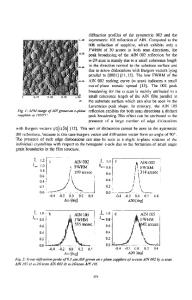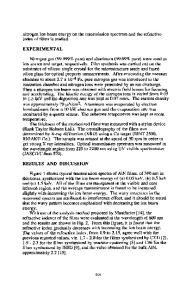Atomic Layer Deposition of Aluminum Nitride Thin films from Trimethyl Aluminum (TMA) and Ammonia
- PDF / 148,768 Bytes
- 6 Pages / 612 x 792 pts (letter) Page_size
- 83 Downloads / 452 Views
D1.9.1
Atomic Layer Deposition of Aluminum Nitride Thin films from Trimethyl Aluminum (TMA) and Ammonia Xinye Liu, Sasangan Ramanathan, Eddie Lee, and Thomas E. Seidel Genus, Inc., 1139 Karlstad Drive, Sunnyvale, CA 94089
ABSTRACT Aluminum nitride (AlN) thin films were deposited from trimethyl aluminum (TMA) and Ammonia (NH3) by thermal atomic layer deposition (thermal ALD) and plasma enhanced atomic layer deposition (PEALD) on 200 mm silicon wafers. For both thermal ALD and PEALD, the deposition rate increased significantly with the deposition temperature. The deposition rate did not fully saturate even with 10 seconds of NH3 pulse time. Plasma significantly increased the deposition rate of AlN films. A large number of incubation cycles were needed to deposit AlN films on Si wafers. 100% step coverage was achieved on trenches with aspect ratio of 35:1 at 100 nm feature size by thermal ALD. X-ray diffraction (XRD) data showed that the AlN films deposited from 370 °C to 470 °C were polycrystalline. Glancing angle X-ray reflection (XRR) results showed that the RMS roughness of the films increased as the film thickness increased.
INTRODUCTION Because of its outstanding properties such as excellent thermal and chemical stability, high thermal conductivity, low thermal expansion coefficient, and wide band gap, AlN has been well studied for various applications such as IC packaging[1], optoelectronic devices[2] and diffusion barriers[3]. A number of methods have been used to deposit AlN[3,4,5,6]. Due to its high dielectric constant (~ 8), we are interested in AlN’s applications in depositing high dielectric constant materials such as aluminum oxynitride (AlON) and aluminum silicon oxynitride (AlSiON) for the next generation microelectronic devices by ALD. To deposit AlON or AlSiON with desired properties, it is essential to understand deposition of AlN. In this study, we investigated ALD of AlN from TMA and NH3, especially the deposition rate, microstructures, and the differences between thermal ALD and PEALD.
EXPERIMENTAL The ALD reactor used in this work was a Genus StrataGem ALD system. TMA and NH3 vapor was delivered into the reactor chamber vertically with a Genus precursor delivery system. The vapor was then distributed by a gas distributor which was also the bottom electrode for plasma generation. The TMA concentration in the reactor was 10% to 15% in partial pressure. The NH3 concentration in the reactor was 20% to 30% in partial pressure. The stainless steel gas lines for delivering the precursors were heated up to 160 °C. Nitrogen was used as the TMA carrier gas and purge gas. No carrier gas was used for NH3. The process chamber pressure was from 100 mTorr to 500 mTorr. The set point of susceptor (the Si substrate holder) temperature was from 200 °C to 470 °C. The actual substrate temperature was 25 ºC to 30 ºC lower than the
D1.9.2
set point. The substrates were 200 mm planar Si (100) wafers for most of characterizations. The wafers were etched by HF vapor prior to the deposition. The RF plasma frequenc
Data Loading...











